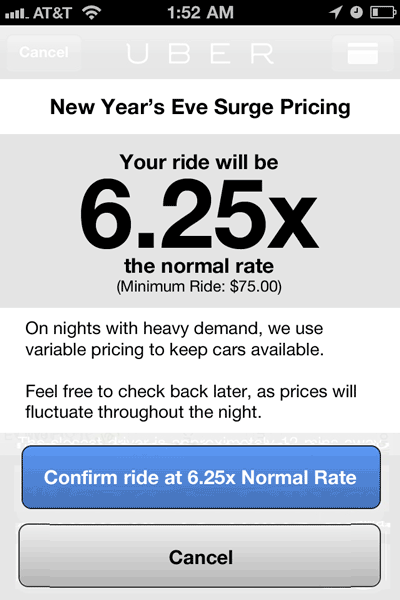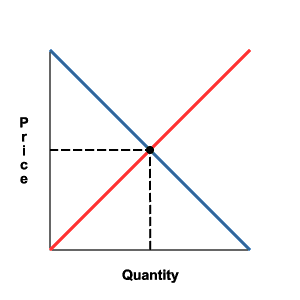As Hurricane Sandy bore down on the Northeast, companies made preparations on how best to cope for the storm. However, while other companies made defensive plans, Uber, the renegade taxi company, went on the offensive. Much like in times of high demand, Uber implemented surge pricing within New York, doubling the cost of a car pick up due to the impact that the storm had placed on New York City. As soon as they flipped the switch, people cried out in complaints that Uber was engaging in price gouging, intentionally taking advantage of customers in their time of need.
Hey @uber_nyc I love you but doubling the price for "intense demand" when there's no transit/disaster sounds like price gouging to me.
— Corey Zaloom (@CoreyZaloom) October 31, 2012
support a local small business—run by industrious immigrants!—and use a nyc car service today instead of uber. happy to recommend my faves.
— lia bulaong (@lia) November 1, 2012
 What makes Uber so different from traditional taxi and limousines companies is that they do not own their own car fleet or pay for drivers for the cars. Rather, they provide iPhones to each driver they enlist, that allows for the driver to pick up fares that are called for from the Uber app. The drivers app keeps track of the total distance traveled and the total cost of the ride, and when the customer arrives at the destination their credit card is automatically charged. Uber takes a 20% cut of the transactions cost and the driver gets to keep the rest of the fare. However, when the market equilibrium is out of sync (more demand for drivers than available supply) , Uber will multiply the price of the ride using what they call Surge Pricing, which they notify the customer up front that they will be charged a much higher price than they are normally used to. This is usually the case on nights with high demand, such as New Years Eve, when the pricing multiple can get up to 7x the normal price causing a 1.5 mile ride to cost over $100.
What makes Uber so different from traditional taxi and limousines companies is that they do not own their own car fleet or pay for drivers for the cars. Rather, they provide iPhones to each driver they enlist, that allows for the driver to pick up fares that are called for from the Uber app. The drivers app keeps track of the total distance traveled and the total cost of the ride, and when the customer arrives at the destination their credit card is automatically charged. Uber takes a 20% cut of the transactions cost and the driver gets to keep the rest of the fare. However, when the market equilibrium is out of sync (more demand for drivers than available supply) , Uber will multiply the price of the ride using what they call Surge Pricing, which they notify the customer up front that they will be charged a much higher price than they are normally used to. This is usually the case on nights with high demand, such as New Years Eve, when the pricing multiple can get up to 7x the normal price causing a 1.5 mile ride to cost over $100.While I'm glad I'm home safely, the $107 charge for my @uber to drive 1.5 miles last night seems insanely excessive. :(
— Aubrey Sabala (@Aubs) January 1, 2012
In the aftermath of Hurricane Sandy, Uber instituted Surge Pricing, doubling the cost of rides in and around the city. As people saw this, they called out Uber for trying to take advantage of people who needed rides with no one else available to fulfill their needs. While the public relations optics of the move are less than optimal, from an economics perspective it makes perfect sense. It is all a matter of supply and demand and what happens when one or both are disrupted from their normal point. When a market is functioning normally supply and demand intersect at a point (called the equilibrium point) which bases the best price that the market is willing to pay as well as the best quantity that the market will provide. When a market is disrupted due to some external event, supply and demand can change causing a new equilibrium point and a new price and quantity.
In the aftermath of Hurricane Sandy, drivers who would usually go out and pick up passengers would prefer to stay at home with their family and loved ones. In other words, they felt that the normal price that they were getting from Uber to pick up passengers was not enough to compensate themselves for the extra work they would have to do. In response to this, Uber tried to make going out to pick up people worth it to the drivers, by doubling the amount that drivers would get as a cost for providing the same ride. As the law of supply states; the more people are willing to pay for a good or service the more of said good or service suppliers will bring to the market. In other words, as Uber increased the price of rides, more drivers would be willing to drive for Uber, since there was more money in it for the drivers themselves.
 While it may make perfect economic sense, it leaves legal and ethical considerations in its wake. New York has a rule against price gouging, stating that during times of emergencies no business may charge "an exorbitant amount" for a good or service. New York does not lay out what constitutes an exorbitant amount and what does not, leaving many cases of suspected price gouging up to the circumstances surrounding the case. However, just across the Hudson River, in New Jersey, a price increase of more than 10% in times of an emergency is considered price gouging and causes levying of huge fines against the gouger. While Uber did double their prices, increasing them 100%, it is not an immoral or unethical action, given the circumstances. Where price gouging is especially harmful to consumers is if all suppliers for a certain good or service increase their prices exorbitantly. In this case, only Uber raised their prices after the storm hit. If a customer did not want to pay the higher price, they could have called for another car service or taxi service. These providers were probably not charging as much as Uber was, however there probably weren't as many cars available for rides as there usually were on a sunny day.
While it may make perfect economic sense, it leaves legal and ethical considerations in its wake. New York has a rule against price gouging, stating that during times of emergencies no business may charge "an exorbitant amount" for a good or service. New York does not lay out what constitutes an exorbitant amount and what does not, leaving many cases of suspected price gouging up to the circumstances surrounding the case. However, just across the Hudson River, in New Jersey, a price increase of more than 10% in times of an emergency is considered price gouging and causes levying of huge fines against the gouger. While Uber did double their prices, increasing them 100%, it is not an immoral or unethical action, given the circumstances. Where price gouging is especially harmful to consumers is if all suppliers for a certain good or service increase their prices exorbitantly. In this case, only Uber raised their prices after the storm hit. If a customer did not want to pay the higher price, they could have called for another car service or taxi service. These providers were probably not charging as much as Uber was, however there probably weren't as many cars available for rides as there usually were on a sunny day. This is hardly the end of the story for Uber, as they put the Surge Pricing back on for New York consumers, while waiving the 20% cut that they get from each ride. As the days and weeks go on, Uber may find that their model of charging what the market is willing to bear may not be worth the increased PR troubles or they may feel that in times of increased demand or decreased supply, these price changes are good ideas.
Agree? Dissagree? Have a Uber horror story? Chime in in the comments below. Also feel free to follow us on Facebook for up to the minute notification on new posts


If the law of supply and demand were applied without limit during natural disasters many more people would suffer. Imagine trying to find food for your kids after hurricane sandy if the price of milk, bread etc. was doubled or tripled during/after the storm?
ReplyDelete^ imagine how hard food would be to find if prices were so cheap in emergencies that people started hoarding goods instead of buying only what they need and leaving more for everyone else.
ReplyDeleteAlso imagine how more suppliers will be drawn to the area in need. By the higher prices.
Why don't people understand this??